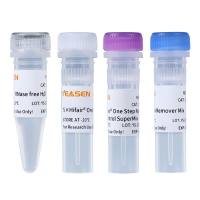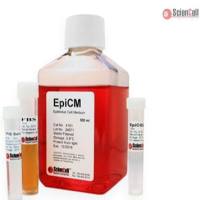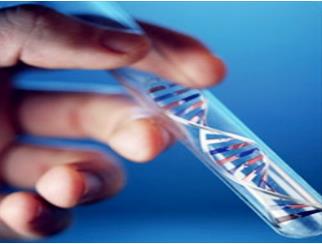细胞培养中的常见污染
互联网
1、Bacteria
Bacteria(cocci) at 320x magnification. In this example, the cells are the larger refractile bodies, while the bacteria appear as very small dark "dots" in the spaces between the cells.
Bacterial contamination is usually manifest by a sudden change in pH, cloudiness in the medium, sometimes with a slight whiteish film on the cell surface of plates, dishes, or on the bottom of bottles of medium that typically dissipates when the vessel is moved. Under low power(100x)spaces between cells will appear granular or you may see very small black dots. In some cases under higher magnification (400x) cocci or "rods" may be distinguished and there may be motibility of the bacteria. Bacteria can usually be distinguished from media components such as serum protein by the regular particulate morphology of the organism versus an irregular shape in the case of serum protein cryoprecipitates.
2、Fungus
(upper Fungus(mold)at 100x magnification,(down) Fungus growing on cells(unusual).
Description: Fungi or molds produce thin filamentous mycelia and sometimes denser clumps of spores. They are easy to observe under a low power microscope and can even be seen without magnification in advanced stages of contamination. They can appear whiteish, yellowish, or black in culture and when in advanced mycelial growth stages look like large fuzzy patches in the dish or flask.
Characteristics in mammalian cell cultures: In early stages of contamination, fungi do not typically cause pH changes in the medium nor do they have significant toxic effects on mammalian cells. Fungi mostly grow in the medium unattached to the cells or growth vessel, but can become attached to either. The spores that give rise to the mycelia formation are often hard to detect in cultures. Cell cultures can often be cured of fungus contamination when detected early by treatment with certain antibiotics(actually antimycotics). See below.
Typical routes of infection in cultures: Fungus and mold spores are ubiquitous in the environment and generally infect cultures via an airborne route. Heating and air-conditioning systems are notorious for having high concentrations of spores. Therefore, the seasonal changes of fall and spring usually result in an increase in this type of contamination in cultures as heating or A/C systems are switched on or off. Also, particularly in the spring, the higher bioburden in the air from pollen particles can carry fungal spores into air handling systems and into labs on the clothes of lab personnel.
Antibiotics: The two most common antimycotic agents used in cell culture that are effective against fungi or molds are Amphotericin B(Fungizone) and mycostatin(Nystatin). Important note: routinely used antibiotics such as penicillin/streptomycin(pen/strep), gentamicin, and kanamycin are NOT effective against fungi or molds. Fungizone can be used in media at final working concentrations between 0.25ug/ml and 2.5ug/ml. Fungizone is typically very toxic in cell culture systems and should be used conservatively. Nystatin can be used at final working concentrations between 100U/ml and 250U/ml. Nystatin is a colloidal suspension rather than a solution and should be mixed thoroughly before it is added to cell culture media. When nystatin is in medium and viewed under a microscope, it will appear as small crystal-like particles. A very useful list of antibiotics, the organisms they are effective against, and recommended working concentrations compiled by the Sigma-Aldrich Company can be found as a pdf document (129Kb, 3 pages) by clicking on the following link. The file will be downloaded and can be opened with Adobe Acrobat Reader.
3、Mycoplasma
Mycoplasma "colony" on a special formula agar plate at 100x magnification.
Mycoplama does not grow as colonies in cell cultures and cannot be detected by light microscopy.
Description: Mycoplasmas(PPLO) are small(0.2 - 0.3 micron) wall-less bacteria that can grow to very high concentrations in mammalian cell cultures, typically 107 - 108 organisms/ml, while remaining unobservable by regular light microscopy. Although late stage mycoplasma contamination can cause cell culture medium to become acidic, usually there are no overt signs that cultures are contaminated other than described below.
Characteristics in mammalian cell cultures: In early stages of contamination, mycoplasmas do not typically cause pH changes in the medium nor do they have significant toxic effects on mammalian cells. Mycoplasmas grow mostly associated with the mammalian cell membranes. In many cases there are no signs of mycoplasma contamination, however, mycoplasma can cause changes in cell growth characteristics, inhibition of cell metabolism, disruption of nucleic acid synthesis, chromosomal abberations, changes in cell membrane antigenicity, and can alter transfection rates and virus susceptability. The only way to confirm mycoplasma contamination is by routine testing using special techniques. The nature of the tests available leads the TCF to recommend using two types of tests for a confirming result while using only one type of test should be considered a presumptive result.
Typical routes of infection in cultures: In most cases mycoplasma contamination occurs through cross-contamination from untested infected cells to other cell lines. The route is typically via airborne microscopic aerosolization during pipetting or some other transfer of medium and/or cells during routine handling when more than one cell line is under the hood at a time or when the same bottle of medium is used for more than one cell line. The best prevention is good aseptic technique in conjunction with routine testing. Always try to work "clean-to-dirty" in order of handling cultures during a work day or week. That is, handle confirmed uncontaminated cells first, unknown or untested cells next, and lastly cells that are suspected or known to be contaminated but must be retained in the lab for special reasons.
Antibiotics: Most routine antibiotics used in cell culture are not effective against mycoplasma. Gentamicin sulfate, kanamycin sulfate, and tylosin tartrate are somewhat effective but may only be inhibitive rather than mycoplasmacidal. A treatment product from Roche Molecular Biochemicals, B-M Cyclin, and the antibiotic ciprofloxacin are two of the most effective treatments for attempting to cure mycoplasma infections but generally have success rates under 80% to 85%.
4、Yeast
Yeast in a suspension-type cell culture at 100x magnification.
Description: If you've ever enjoyed really good bread and a cold beer(good only in this combination when nothing else is in the fridge)you would agree that, in general, yeast is man's friend. Yeast is used to ferment the sugars of various grains to produce alcoholic beverages and in the baking industry to expand dough. But in the world of mammalian cell culture, yeast is an unwelcome guest. Yeasts are true fungi of the phylum Ascomycetes Hemiascomycetes. Yeasts have a great number of natural habitates including plant leaves and flowers, soil, and water where they help decompose plant and algal matter, and are also found on the skin surface and in the digestive tract of mammals. They propagate as single cells that divide by budding or direct division and can grow rapidly(doubling times of less than 12 hours in some cases)in contaminated cell cultures.
Characteristics in mammalian cell cultures: In early stages of contamination, yeasts do not typically cause pH changes in the medium. However, as infection increases cell culture medium will become cloudy to the naked eye and the pH may become basic. At 100x magnification yeasts appear as separate round or ovoid particles or in chains of two to four or more particles and can sometimes be multi-branched. The appearance of chains is due to the most common form of replication called budding. Yeasts are easily distinguished from bacteria by size. Yeasts are larger than bacteria and smaller than typical mammalian cells(see example above).
Typical routes of infection in cultures: Initial yeast contamination in cell culture is generally via an airborne route but yeasts can readily "colonize" an incubator and can then be spread to other cultures by contact of contaminated flask or dish surfaces during cell culture manipulation. Yeast is probably the easiest of the common cell culture contaminants to "cure". Contact the staff at the TCF for recommendations and protocols.
Antibiotics: The two most common antimycotic agents used in cell culture that are effective against yeasts are Amphotericin B(Fungizone) and mycostatin(Nystatin). Important note: routinely used antibiotics such as penicillin/streptomycin(pen/strep), gentamicin, and kanamycin are NOT effective against yeasts. Fungizone can be used in media at final working concentrations between 0.25ug/ml and 2.5ug/ml. Fungizone is typically very toxic in cell culture systems and should be used conservatively. Nystatin can be used at final working concentrations between 100U/ml and 250U/ml. Nystatin is a colloidal suspension rather than a solution and should be mixed thoroughly before it is added to cell culture media. When nystatin is in medium and viewed under a microscope, it will appear as small crystal-like particles.
5、tips: How to prevent contamination in cell culture?
During times of high concentrations of airborne particulates, such as in the spring during pollen season and during construction when dust and dirt is created, there is a statistically higher chance of having contamination due to airborne spores and other microorganisms associated with the dust and the airborne particulates. I thought it might be helpful for us to alert our users of this potential and make some recommendations about what can be done to try to reduce the risk.
1. Have the air flow rate in your hood(s) checked. As HEPA filters load over time, the pressure drop will increase and the flow rate may be reduced to levels below the rate required for the stability of the laminar flow. If this happens, there is a higher likelihood that air turbulence within the cabinet will occur during a manipulation that could lead to contamination from an airborne source. The air flow rate should not be less than 80-85 feet per minute. UNC Health and Safety has an anemometer and can check this for you or the TCF can recommend a third party vendor.
2. Reduce traffic in your cell culture rooms, especially near the hoods. Traffic causes air turbulence at the hood opening and can compromise the protective air barrier that is created by the downward flow of air inside the cabinet at the opening. Spore-carrying dust particles or other airborne contaminates could get into the working area and ultimately find their way into your media or cultures.
3. Do not use flames(bunsen burners, etc.) under the hood. This will cause air turbulence over the flame and in the working area that could lead to spores from your lab coat, for example, being caught up in the turbulence and blown into your media bottle, flask, or, dish, etc. All routine cell culture manipulations can be done without flaming by using appropriate aseptic and sterile technique. We will be glad to offer specific suggestions and training regarding this if necessary.
4. Make sure all interior hood surfaces are adequately disinfected, preferably by using chemical disinfectants such as 70% ethanol, dilute hypochlorite, or a dilute quaternary ammonium solution such as 1% benzalconium chloride. Freshness of the solutions and adequate contact time are important for these to work properly.
5. Consider using TC flasks with vented filter caps instead of flasks that require loosened caps for gas exchange or dishes. These flasks tend to reduce airborne contamination and especially the spread of contamination from one vessel to another while in the incubator. These flasks are more costly but it may be worth the extra cost considering the higher risk at this time. At least you may consider using them for stock cultures or for extremely important cultures.
6. If you experience chronic contamination problems, you may want to consider using an antibiotic(with an anti-mycotic component for fungal or yeast problems). Whereas I don't recommend them for routine use, sometimes they may be necessary in certain situations or in areas with unusually high concentrations of airborne particulates. We can make specific recommendations as to which antibiotics to use and at what concentrations. Please note that pen/strep offers no protection against fungus.
7. It may be useful to monitor the airborne microbial levels in your cell culture rooms and even within your hoods(it should be 0 in hoods) by using Nutrient Agar and Sabouraud Dextrose Agar plates. Nutrient agar will give you information about airborne bacteria levels and Sabouraud dextrose agar will detect airborne fungi and spores. Put plates at various locations in the lab and in your hood. Take the lids off for a set period of time, 30 minutes for example. Collect the plates and incubate the nutrient agar plates for 3 to 5 days and the Sabouraud dextrose agar plates for 7 to 10 days. Remember not to incubate these plates in incubators with your cell cultures! Take a total plate count and note the locations that seem to be high. Depending on what you find, there may be steps you can take to reduce the level of airborne contaminants.








